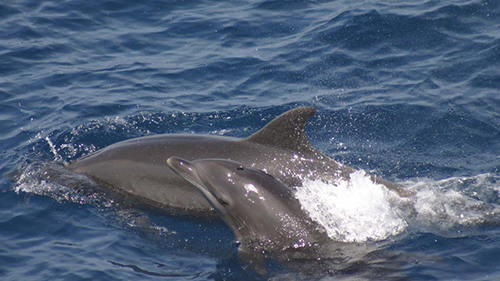![Dolphin proteins may help researchers find a way to protect humans' kidneys during a heart attack, stroke, or acute kidney injury. [NOAA]](https://genengnews.com/wp-content/uploads/2018/08/bottlenose_calf_swfsc2082190731-1.jpg)
Dolphin proteins may help researchers find a way to protect humans’ kidneys during a heart attack, stroke, or acute kidney injury. [NOAA]
Dolphins and other marine mammals can survive deep dives that deprive vital organs of oxygen without causing damage—a scenario for humans that would be lethal. During dives that can last as long as 90 minutes, marine mammals restrict blood flow to their kidneys, liver, heart, and lungs to shunt more oxygen to the brain.
Now, researchers from the Medical University of South Carolina (MUSC) are looking into the protective proteins that dolphins seem to have that may contain clues to treatments for aging-associated diseases in humans. When marine mammals resurface from deep dives, oxygenated blood flow is restored without the deprived organs suffering damage. However in humans, the same phenomenon of hypoxia followed by reoxygenation—as experienced during a heart attack, stroke, and acute kidney injury—causes the release of free radicals thought to damage human organs.
In the current study, the investigators found that dolphin serum contains very high levels of an antioxidant protein that likely has a protective effect for the hypoxic organs. The findings from this new study were published recently in Scientific Reports in an article entitled “Proteomic Analysis of Non-depleted Serum Proteins from Bottlenose Dolphins Uncovers a High Vanin-1 Phenotype.” The research team is optimistic that their discovery could be used in future studies for the development of preventative therapies.
The scientists used proteomics in an attempt to determine what gives dolphins their advantage in hypoxic situations.
“We attempted to analyze all the proteins at once rather than individual proteins at one time in a cell or a tissue or an organism,” explained senior study investigator Michael Janech, Ph.D., associate professor at MUSC. “It's just like genomics—when people are looking at 20,000 genes and seeing if they are high or low in certain disease states. We're doing the same thing with certain proteins.”
Yet, this is no small feat, as the diversity among proteins is exponentially higher than it is for nucleic acids.
“There are more than 100,000 protein variants, but each protein can be modified. We have more than a million different protein variants based on modifications,” Dr. Janech added.
Dr. Janech became interested in studying dolphins when he learned that some of the managed dolphins in the U.S. Navy Marine Mammal program were living much longer than wild ones. The marine mammals were developing insulin resistance and fatty liver disease as they aged, a process consistent with the development of metabolic syndrome in people. This observation presented a rare opportunity for study.
“That's not a model that anybody sees in nature because dolphins usually don't get this old in nature,” Dr. Janech noted.
Dr. Janech and his colleagues attempted to determine the cause of insulin resistance in managed dolphins, hoping to use the knowledge of human and dolphin similarities to find clues for treating the condition in both species. The researchers quickly began to track the protein adiponectin in the serum of the managed and wild bottlenose dolphin populations.
The researchers predicted that levels of adiponectin, an insulin-sensitizing hormone, would be different in managed dolphins with metabolic syndrome in comparison with those in the wild. To verify the relevance of their work to the human metabolic syndrome, they also performed simple proteomic analyses in human and dolphin serum samples.
The research team found that eleven proteins were at least 100-fold more prevalent in dolphin serum than in humans—which at first they dismissed to evolutionary branching.
Yet, bottlenose dolphins are mammals descended from even-toed ungulates such as pigs, deer, and giraffes. Interestingly, the scientists also mapped the serum proteome of the pig and were again surprised. The 100-fold rank differences in five of the proteins, including vanin-1 and adiponectin, could not be explained away by simple phylogenetic differences.
While adiponectin is known to be higher in dolphins, as a way to control glucose storage during feeding, very high vanin-1 was a novel finding. Excessively high vanin-1 levels were correlated with decreased liver function in the wild dolphins, which suggests they provide a protective effect in avoiding metabolic syndrome. The function of vanin-1 is to make vitamin B5, and in doing so, it releases an antioxidant that has been shown to protect tissues from an injury like that which occurs after the hypoxia and reoxygenation of diving and resurfacing.
The researchers are now looking to see if their findings have true relevance toward human disease states.
“This is the first step. We wanted to ask what's different in an animal that can do something that would hurt a human, and they do this every single day,” Dr. Janesch remarked. “And can we take it back to human medicine?”







